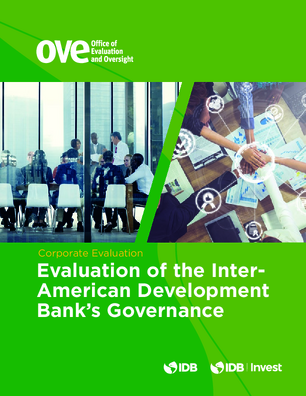Evaluation of the Inter-American Development Bank's Governance
Date
Jun 2022
The evaluation's objective was to assess the extent to which the IDB's governance arrangements allow it to operate effectively and efficiently while providing sufficient accountability, transparency, and stakeholder voice in decision-making. The analysis covered the period from the IDB's establishment in 1959 to September 2020, with special attention paid to the last decade. The evaluation focused on the Bank's governing bodies (the Board of Governors, Board of Executive Directors, and Senior Management) and drew conclusions and recommendations on structural problems affecting the IDB's governance.
The evaluation found that the Bank's governance arrangements, in general, have allowed the institution and its governing bodies to function adequately. Nonetheless, OVE identified certain factors that hinder the effectiveness, efficiency, and accountability of the Bank's governing bodies and exacerbate the natural information asymmetries stemming from the principal-agent relationship that exists between the governing bodies, giving rise to problems of adverse selection and moral hazard.
These factors include the lack of clear delineation of the roles and responsibilities of the governing bodies, leading to gaps, duplications, and tensions. Moreover, the selection process of the members of the Board of Executive Directors, under the authority of the different member countries, does not ensure that, as a group, this body has the skills and experience necessary to perform all of its fiduciary responsibilities. The high turnover rate of Executive Directors (among the highest for multilaterals) and their weak onboarding program create knowledge gaps and loss of institutional memory at the Board level that exacerbate this issue.
At the same time, there are deficiencies in the agenda setting and meeting management of the various governance bodies, as well as problems in Board members' access to relevant information. The Secretary of the Bank's exclusive line of reporting to the Presidency contributes to these issues.
Finally, OVE identified two additional elements that hinder accountability and exacerbate conflicts of interest. The first is the absence of a comprehensive accountability framework for Senior Management and of a self-evaluation mechanism for the Board of Executive Directors. The second is that the Bank's President is elected by the Board of Governors (not by the Board of Executive Directors) and serves as the chair of the Board of Executive Directors, complicating the Board of Executive Directors' ability to hold Senior Management accountable for its commitments, actions, and conduct.
Based on the evaluation's findings, OVE made 12 recommendations aimed at addressing the identified structural issues that hinder the effectiveness, efficiency, and accountability of the Bank's governance. The Board of Executive Directors welcomed this important evaluation and endorsed all the recommendations.
The evaluation found that the Bank's governance arrangements, in general, have allowed the institution and its governing bodies to function adequately. Nonetheless, OVE identified certain factors that hinder the effectiveness, efficiency, and accountability of the Bank's governing bodies and exacerbate the natural information asymmetries stemming from the principal-agent relationship that exists between the governing bodies, giving rise to problems of adverse selection and moral hazard.
These factors include the lack of clear delineation of the roles and responsibilities of the governing bodies, leading to gaps, duplications, and tensions. Moreover, the selection process of the members of the Board of Executive Directors, under the authority of the different member countries, does not ensure that, as a group, this body has the skills and experience necessary to perform all of its fiduciary responsibilities. The high turnover rate of Executive Directors (among the highest for multilaterals) and their weak onboarding program create knowledge gaps and loss of institutional memory at the Board level that exacerbate this issue.
At the same time, there are deficiencies in the agenda setting and meeting management of the various governance bodies, as well as problems in Board members' access to relevant information. The Secretary of the Bank's exclusive line of reporting to the Presidency contributes to these issues.
Finally, OVE identified two additional elements that hinder accountability and exacerbate conflicts of interest. The first is the absence of a comprehensive accountability framework for Senior Management and of a self-evaluation mechanism for the Board of Executive Directors. The second is that the Bank's President is elected by the Board of Governors (not by the Board of Executive Directors) and serves as the chair of the Board of Executive Directors, complicating the Board of Executive Directors' ability to hold Senior Management accountable for its commitments, actions, and conduct.
Based on the evaluation's findings, OVE made 12 recommendations aimed at addressing the identified structural issues that hinder the effectiveness, efficiency, and accountability of the Bank's governance. The Board of Executive Directors welcomed this important evaluation and endorsed all the recommendations.




